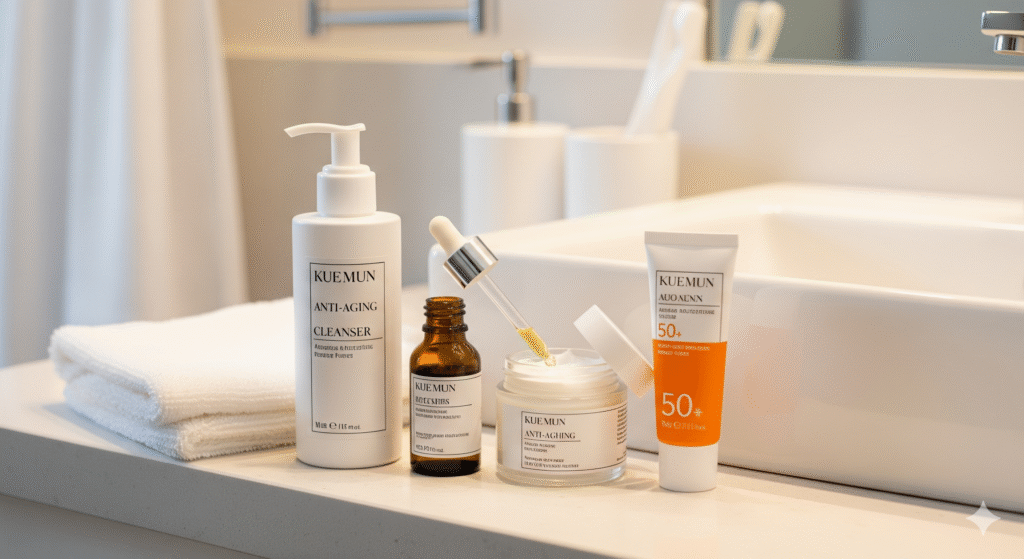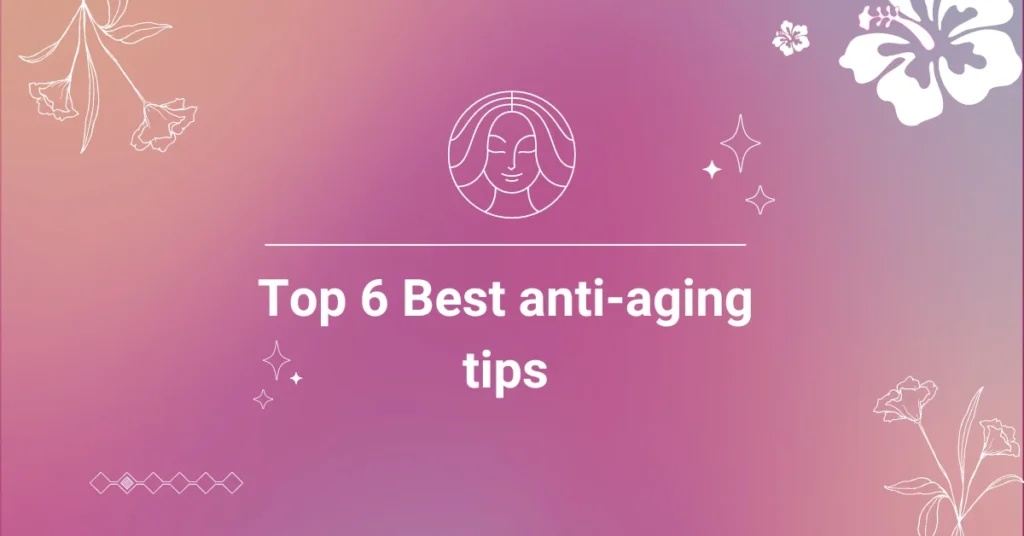Aging is inevitable, but how your skin shows its age is very much within your control. With the right routine, you can slow visible signs such as fine lines, wrinkles, dullness, and sagging. An effective anti-aging skincare routine blends scientific knowledge, expert-recommended ingredients, and consistent habits. This guide will help you build a practical, safe, and results-driven regimen that works for your skin type and lifestyle.
Table of Contents
-
What Causes Skin Aging
-
Key Ingredients & Their Roles
-
Building Your Daily Routine (Morning vs Night)
-
Weekly & Occasional Treatments
-
Lifestyle Habits That Boost Skin Health
-
Common Mistakes & How to Avoid Them
-
FAQ
-
Conclusion
1. What Causes Skin Aging
To understand how to fight or slow aging, it’s important to know why aging happens.
-
Intrinsic aging: This refers to the natural aging process inside the body — genetics, decline in collagen and elastin production, slower cell turnover, decreased hydration, and natural hormonal changes.
-
Extrinsic aging: Caused by outside factors. The biggest is UV exposure (sunlight), plus pollution, smoking, poor diet, lack of sleep, stress, harsh skincare products, and environmental toxins.
Many visible signs — dark spots, loss of firmness, fine lines, dryness — are either caused or accelerated by extrinsic factors. That’s why a good anti-aging routine both prevents damage and supports repair.
2. Key Ingredients & Their Roles
When choosing products, focus on ingredients that have strong evidence for anti-aging benefits. Here are the most important ones:
| Ingredient | What It Does | How to Use It Safely |
|---|---|---|
| Retinoids / Retinol / Retinaldehyde / Tretinoin | Boosts cell turnover, increases collagen & elastin, reduces wrinkles & fine lines. | Start slow: use a low-strength product, maybe 2-3 times a week. Apply at night, avoid combining with other irritants initially. Use moisturizer and always use sunscreen in the morning. |
| Vitamin C (L-ascorbic acid or stable derivatives) | Powerful antioxidant; brightens skin, evens out tone, neutralizes free radicals from sun & pollution. | Morning use, in serum form. Store properly (Vitamin C oxidizes). Pair with sunscreen. |
| Peptides | Chains of amino acids that can stimulate collagen production, help firm skin. | Use as serums or in creams; often layered under moisturizer. Patch test first. |
| Hyaluronic Acid (HA) | Hydrates by attracting moisture into the skin; plumps fine lines. | Use in both AM & PM; apply on slightly damp skin then seal with moisturizer. Different molecular weights help deeper penetration. |
| Niacinamide | Improves skin barrier, reduces inflammation, regulates oil, brightens, improves texture. | Use daily; works well with many other actives. |
| AHAs / BHAs (e.g. glycolic, lactic acids, salicylic acid) | Gentle exfoliation to remove dead skin cells, help improve texture & brightness. | Use 1-3 times per week depending on strength and your skin’s tolerance. Avoid over-exfoliation. |
| Ceramides / Squalane / Emollients / Occlusives | Help maintain or repair the skin barrier, prevent moisture loss, support resilience. | Especially useful at night and when skin feels dry or sensitive. |
| Sunscreen (broad-spectrum UVA + UVB) | Protects against photoaging: UV rays break down collagen & elastin, cause pigmentation, wrinkles. | Use every single morning; SPF 30 or higher. Reapply every 2 hours if outdoors. Even on cloudy days. |
3. Building Your Daily Routine
To get maximum benefit, your routine should be consistent. Morning and evening routines differ because daytime is about protection; nighttime is about repair and renewal.
Morning Routine (AM)
-
Gentle Cleanser
Choose a mild, non-stripping cleanser. Your skin needs to start fresh but not dry. -
Antioxidant Serum (Vitamin C or similar)
Helps neutralize environmental damage through the day. -
Moisturizer + Barrier Support
Use one suited to your skin type; include ceramides, etc., if barrier is compromised. -
Sunscreen (Broad-Spectrum SPF 30-50+)
This is arguably the most important step. Without this, many anti-aging treatments won’t be fully effective.
Evening Routine (PM)
-
Double Cleanse (if wearing makeup/Sunscreen)
Oil-based or balm cleanser first if needed, then a gentle second cleanser. -
Active Treatment
Depending on your skin’s tolerance: retinoid, AHA/BHA exfoliant, or other targeted serums. -
Hydrating Serum (e.g. Hyaluronic Acid, Peptides)
To boost moisture and support repair. -
Moisturizer / Night Cream
Something richer or with repairing ingredients (like peptides, ceramides, etc.). -
Eye Cream / Neck & Décolletage Care
Skin here is thinner and often shows signs earlier; extending care helps.
4. Weekly & Occasional Treatments
These are not daily, but when used correctly, they can significantly boost results:
-
Exfoliation: chemical exfoliants (AHA, BHA) 1-3×/week depending on strength & skin sensitivity. Avoid harsh physical scrubs.
-
Sheet Masks / Hydrating Masks: once or twice a week for hydration and calming.
-
Facial Oils: at night, for very dry or mature skin; to seal in moisture.
-
Retinol/Retinoid ramping: increase strength gradually; maybe alternate nights. If you get irritation, slow down or buffer with moisturizer.
5. Lifestyle Habits That Boost Skin Health
Anti-aging isn’t just about creams and serums. Your internal health and habits play huge roles.
-
Diet: Eat antioxidant-rich foods (fruits, veggies, nuts, fatty fish). Limit sugars, processed foods. Omega-3 fatty acids help with inflammation and skin repair. Boston Derm Advocate
-
Hydration: Drink enough water. Moisturize skin properly.
-
Sleep: Skin repairs itself during sleep; aim for 7-9 hours per night.
-
Stress Management: High stress causes cortisol spikes, which can degrade collagen and make skin more reactive. Meditation, yoga, hobbies help.
-
Avoid Smoking / Limit Alcohol: Both contribute to oxidative stress and degrade skin structure.
-
Sun Protection Beyond Sunscreen: Wear hats, sunglasses, seek shade, avoid sun during peak UV hours.
6. Common Mistakes & How to Avoid Them
| Mistake | Why It Hurts | How To Fix |
|---|---|---|
| Over-exfoliating / Using too many actives at once | Damages barrier, causes irritation, redness, peeling, which can make skin age faster. | Introduce actives one at a time; patch test; give skin rest days. |
| Skipping SPF or not reapplying | UV rays do cumulative damage; sunscreen is your best defense. | Use broad spectrum SPF every morning; reapply if outdoors. |
| Using products unsuitable for your skin type | Could cause breakouts, sensitivity, dryness or oiliness. | Understand your skin type; choose lightweight or richer formulas accordingly. |
| Ignoring neck, hands, and décolleté | These areas often show aging but are neglected. | Extend your routine (cleansing, sunscreen, moisturizer) to these areas. |
| Inconsistency | Even the best routine won’t work if used irregularly. | Make routines simple; choose products you’ll stick with. |
7. FAQ
Here are some frequently asked questions about anti-aging skin care:
Q1. At what age should I start an anti-aging routine?
You can start preventive measures (like sunscreen and basic moisturizers) in your 20s. More active ingredients (retinol, stronger antioxidants) can be added gradually, often in late 20s to 30s, depending on skin type and concerns. Early prevention gives you a smoother path later.
Q2. How often should I use retinol, and when will I see results?
Start with low frequency (e.g. 2-3 nights per week). As skin tolerates it, you can increase. Some improvements (texture, brightness) may show in 4-8 weeks; more significant wrinkle reduction may take 3-6 months. Always use sunscreen with retinol.
Q3. Can I use vitamin C and retinol together?
Yes, but with care. Vitamin C in the morning and retinol at night is a safe strategy. Using both at night might cause irritation for sensitive skin. Also ensure skin is properly cleansed and moisturized when using strong actives together.
Q4. What is the best sunscreen to use? Mineral or chemical?
Both have their pros:
-
Mineral sunscreens (zinc oxide, titanium dioxide) are gentler, good for sensitive skin.
-
Chemical sunscreens are often lighter and easier to embed in certain formulations.
Choose one that you’ll use consistently, provides broad-spectrum protection, and has SPF 30 or above.
Q5. How do I tell if a product is harming my skin barrier?
Signs include: stinging, burning, redness, flaking, dryness, increased sensitivity. If these occur, stop the product, simplify your routine, focus on repairing barrier (moisturizers with ceramides/emollients), and allow healing.
Q6. Are expensive products always better?
Not necessarily. Many mid-range or even drugstore products contain proven active ingredients. What matters more is ingredient quality, concentration, formulation, stability, and consistency of use.
Q7. Can lifestyle alone reverse aging?
Lifestyle (diet, sleep, sun protection, hydration, stress-management) plays a huge role. But after a point, due to genetics and cellular aging, topical treatments with scientifically proven ingredients become necessary to slow or partially reverse visible aging.
8. Conclusion
A thoughtful, consistent anti-aging skincare routine is your best defense against premature aging. Start with sun protection, build with moisturizers and barrier care, then layer in proven actives like vitamin C, retinol, peptides, and exfoliants — all aligned with your skin type. Don’t forget that habits outside skincare (sleep, nutrition, stress) are equally powerful.
Growth in skin health is a marathon, not a sprint. Be patient. Track your progress monthly. Over time, with consistency and care, you can maintain radiant, youthful skin well into later years.


